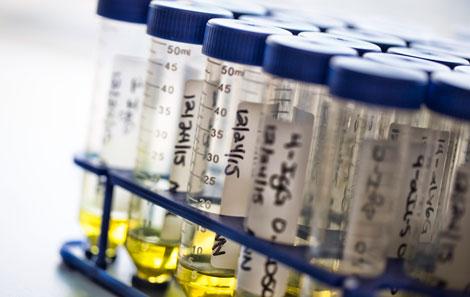LGL Leukemia Program

Make an Appointment
Large granular lymphocyte (LGL) leukemia is a rare form of blood cancer, with fewer than 1,000 new cases diagnosed in the U.S. each year. Because it's so rare, doctors often overlook or misdiagnose the disease.
UVA Cancer Center specializes in the diagnosis and treatment of LGL leukemia. Here you'll find the latest in:
- Research-based care
- Knowledge of advanced therapies
- Access to state-of-the-art facilities, supportive care and ancillary services
Top-Rated Leukemia, Lymphoma, & Myeloma Care
Our leukemia, lymphoma, and myeloma care is recognized as some of the best in the country. U.S. News & World Report has ranked our care for these blood cancers as "high-performing," their highest rating.
World LGL Leukemia Expert
More than 30 years ago, Thomas P. Loughran, Jr., MD discovered LGL leukemia. Since then, he's dedicated his research and clinical focus to understanding this rare disease.
[MUSIC PLAYING]
All of us in cancer research, as well as clinicians, our first goal in treating a patient is get them into remission, which means all evidence of cancer goes away. The second step is making sure that disease never comes back again.
Hi. My name is Tom Loughran.
I'm director of the University of Virginia Cancer Center. My research interest is on LGL leukemia. What I'd like to do today is tell you a little bit about the illness, why I think it would be important for you to see me here, if at all possible, and then give you some idea of our ongoing research in this illness. I discovered LGL leukemia back in Seattle when I was a fellow about 30 years ago. It's a fairly rare disease.
It's characterized by having too many LGL cells, which are clonal.
Clonal means that one cell became abnormal, and then it copies itself over and over again. Our patients become sick by having either too low blood counts or having autoimmune diseases like rheumatoid arthritis.
Our LGL Leukemia Registry is really a worldwide registry to capture clinical information about our patients. Our research is very comprehensive. It's organized around the registry itself, our laboratory, and then clinical trials.
So in conclusion, the overarching goal of our research program is to understand the pathogenesis or causes of LGL leukemia much better so that we can define the illness better, but most importantly, come up with better treatment options. Right now, we have medicines that act broadly to suppress the immune system. They are very effective in controlling LGL leukemia, but so far, unfortunately to date, we have no therapy that can cure this illness.
[MUSIC PLAYING]
Help Us Find a Cure
Support our efforts to find potential cures for LGL leukemia: Make a gift today.
LGLs in Your Blood
In normal blood, 10-15% of white blood cells or lymphocytes are large granular lymphocytes (LGLs). LGLs have a characteristic appearance. Larger than normal lymphocytes, they contain pink granules. Part of the normal immune system, LGLs fight viruses.
Large granular lymphocyte leukemia results from having too many LGLs in your blood; either more LGLs than normal, or a higher percentage compared to other types of white blood cells.
Types & Features
Two types of LGL leukemia can occur:
- T-cell
- NK-cell
T-cell LGL Leukemia
A chronic disease, this type of leukemia:
- Usually occurs in people between 50 and 60
- Causes anemia half the time
- Results in an enlarged spleen half the time
Patients often have recurring bacterial infections, rheumatoid arthritis and neutropenia.
NK-cell LGL Leukemia
NK-cell LGL leukemia comes in two forms, chronic and acute. The chronic form has similar features to T-cell LGL leukemia.
The acute form occurs rarely, but happens rapidly. Most patients:
- Experience systemic symptoms, like fever and weight loss
- Have massive enlargement of the liver and spleen
- Get anemia
- Suffer from severe neutropenia
- Die within two months of diagnosis
Symptoms of Both LGL Leukemia Types
- Repeated infections
- Frequent fevers
- Night sweats
- Unintended weight loss
- Weakness
Diagnosis
LGL leukemia can be diagnosed by conducting several tests, including:
- Complete blood count (CBC), usually first test to show the main sign of LGL leukemia, high white blood cell count and low neutrophil count
- Flow cytometry with an LGL Panel, which can show what type of LGL leukemia is present
- T-cell receptor gene rearrangement (TCR) further tests for types of T-cell clones
- Bone marrow biopsy
- Splenectomy and spleen analysis
Treatments
- Splenectomy (removal of the spleen)
- Blood transfusions (to treat anemia)

LGL Leukemia Registry
We're home to the LGL Leukemia Registry, the only national registry that collects, manages and analyzes information on people with LGL leukemia. The registry also maintains a bank of tissue and blood samples from LGL patients. Find out how you can help researchers by participating in the registry.
Join the Registry